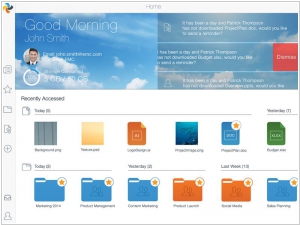Citrix ShareFile vs Syncplicity
August 26, 2023 | Author: Michael Stromann
8
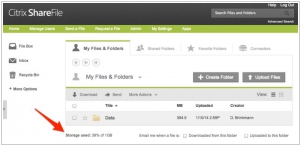
ShareFile allows businesses to securely send large files to anyone, anywhere. Send big files up to 100 GB from your PC, Mac, or mobile device. Citrix ShareFile allows you to create a custom-branded, password-protected space where you can exchange business files with clients easily and securely. Whether you need to send large files by email, conduct a secure file transfer or set up a collaboration space for project-related files, ShareFile has the solution for you.
Citrix ShareFile and Syncplicity are both cloud-based file sharing and collaboration platforms, but they have distinct features and cater to different needs.
Citrix ShareFile is known for its robust security and compliance capabilities. It offers advanced security features such as encryption, access controls, and data loss prevention, making it suitable for organizations with strict security requirements. ShareFile also provides features like audit trails, e-signatures, and secure client portals, making it popular among industries such as legal, finance, and healthcare.
Syncplicity, on the other hand, focuses on simplicity and ease of use. It offers intuitive file sharing and syncing capabilities, allowing users to access and collaborate on files from any device. Syncplicity emphasizes user-friendly features such as automated file synchronization, easy sharing options, and real-time collaboration.
See also: Top 10 Cloud Storages
Citrix ShareFile is known for its robust security and compliance capabilities. It offers advanced security features such as encryption, access controls, and data loss prevention, making it suitable for organizations with strict security requirements. ShareFile also provides features like audit trails, e-signatures, and secure client portals, making it popular among industries such as legal, finance, and healthcare.
Syncplicity, on the other hand, focuses on simplicity and ease of use. It offers intuitive file sharing and syncing capabilities, allowing users to access and collaborate on files from any device. Syncplicity emphasizes user-friendly features such as automated file synchronization, easy sharing options, and real-time collaboration.
See also: Top 10 Cloud Storages
Citrix ShareFile vs Syncplicity in our news:
2014. Citrix acquired digital signature service RightSignature
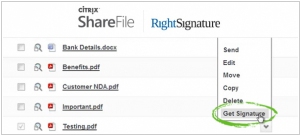
Citrix has recently acquired RightSignature, a leading electronic document signing platform that seamlessly complements Citrix's ShareFile, a file storage, sync, and sharing platform. Over the past year, the two companies have collaborated and successfully integrated their solutions. ShareFile is widely used by users for on-premises storage or to facilitate data mobilization in existing systems like SharePoint or file shares. With the incorporation of RightSignature, users can now maintain the security and confidentiality of their documents. RightSignature offers an elegant and intuitive user interface, replicating the experience of pen-and-paper signing within any web browser. The integration between ShareFile and RightSignature is already available as an add-on for all ShareFile accounts, empowering users with a comprehensive and seamless document signing experience.
2014. EMC Syncplicity cuts prices
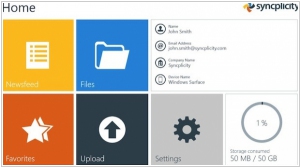
According to industry leaders Forrester and Gartner, EMC's Syncplicity is regarded as the top-notch offering in the Enterprise Sync and Share market. However, EMC aims to eliminate any potential barriers that may prevent companies from fully embracing its comprehensive solution. As part of this effort, EMC has increased storage limits across all its offerings. Individuals with free personal accounts can now enjoy storage capacity of up to 10 GB without incurring any charges. Subscribers to the business edition have a generous allocation of 300 GB + 5 GB per user, with the option to obtain additional storage at a reasonable price. Users of the departmental edition are granted up to 1 TB of storage without incurring extra fees. Furthermore, the storage capacity for the Enterprise edition remains unlimited, as it has always been.
2014. Syncplicity launches iPhone app expanding virtual private cloud capabilities
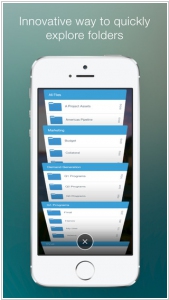
The cloud-based file management service, Syncplicity, has recently launched a new iPhone app that offers mobile accessibility to all user files and folders. This app not only provides convenient access but also fulfills crucial business requirements such as security, backup, and versioning. Users can now effortlessly browse, share, and manage their files and folders directly from their iPhones, regardless of whether the files are stored on their PC, Mac, SharePoint servers, corporate network, or in Google Docs. This universal file access on the iPhone encompasses shared Syncplicity folders designed for collaboration within businesses or for personal sharing. With Syncplicity, users can securely access any file and folder at any time, eliminating the need to rely on email attachments or carry laptops and use VPNs to ensure file access while on the move. Syncplicity also prioritizes mobile safety by incorporating built-in policy and permission controls, remote wipe capabilities, and comprehensive end-to-end encryption for all transferred and stored data on the Syncplicity service as well as on the mobile device.
2012. EMC buys file syncing service Syncplicity
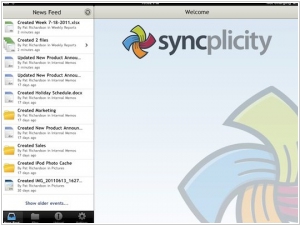
The conquest of the Enterprise continues for Dropbox for Business. EMC, the developer of the largest and most intricate enterprise content management system Documentum, has recently acquired Syncplicity, a small file storage and syncing service. This acquisition is expected to enable Documentum users to access and work with files stored in the ECM system from their mobile devices. It's worth noting that EMC has a subsidiary, VMWare, which is developing its own similar service called Project Octopus. However, it seems that EMC couldn't afford to wait any longer, as this matter required immediate attention. Interestingly, Open Text, the main competitor in the ECM market, had already launched a file syncing service called Tempo at the beginning of the year. Syncplicity, one of the early competitors of Dropbox, may not have achieved the same level of popularity, but it had a strong focus on the business sector and boasted more robust security features compared to Dropbox.
2008. Syncplicity Announces New Platform
Syncplicity, a synchronization, backup, and sharing solution, has unveiled a new open platform aimed at enabling the next generation of Cloud Computing applications. The platform empowers developers to seamlessly integrate their web-based applications with desktops, facilitating smooth interaction between online apps and locally stored files. By leveraging open standards, the platform enables file synchronization not only across computers and devices but also on the web. This means that desktop files can be instantly accessed in online or local applications, granting web apps the same versatility on the desktop. Additionally, files can be edited in any application, online or on the PC, and automatically backed up and saved directly to the user's hard drive. This eliminates the hassle of locating recently saved files and allows users to choose their preferred application without concerns about data storage. Syncplicity has also introduced a new pricing plan featuring free and premium accounts, along with partnerships with prominent web-based services for documents and photos, including Scribd, Zoho, and Picnik.
2008. Syncplicity Online Backup Opens Public Beta
Syncplicity is launching today with similar value propositions to SugarSync. It offers automatic file backup from any location on your computer, file synchronization between computers, and file sharing with friends. One of its standout features is the ability to sync Microsoft Office documents with Google Docs in both directions, unlike DocSyncer, which only pushes files to Google. Another player in the online storage space is Allmydata, a veteran company that recently revamped its backup product with version 3.0. While Allmydata has moved away from its peer-to-peer roots, it still offers a client for Mac and PC users to set up a virtual drive with unlimited storage for $5 per computer. Although primarily focused on personal backup, it does provide a web interface for accessing files on the go. Amidst the crowded market, with companies like Dropbox, HP Upline, Box.net, and Xdrive, one notable absence is Google. Despite long-standing rumors of the GDrive or "My Stuff," Google has yet to deliver a comprehensive online storage solution. However, if Google were to integrate file backup with its cloud software and provide appropriate APIs, it could revolutionize the Web 2.0 movement, drive adoption of its software and browser-based applications, and create new opportunities for startups.

